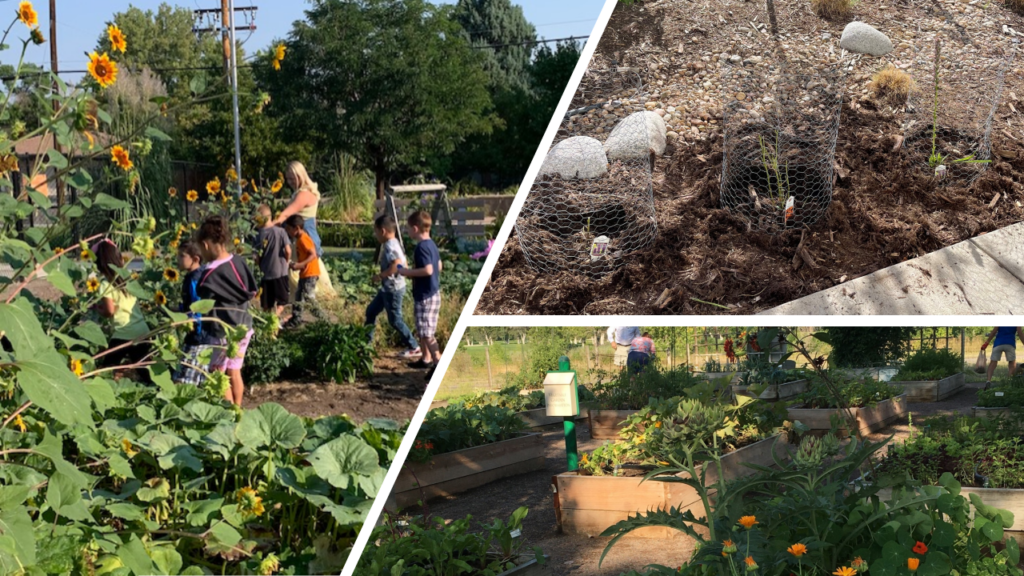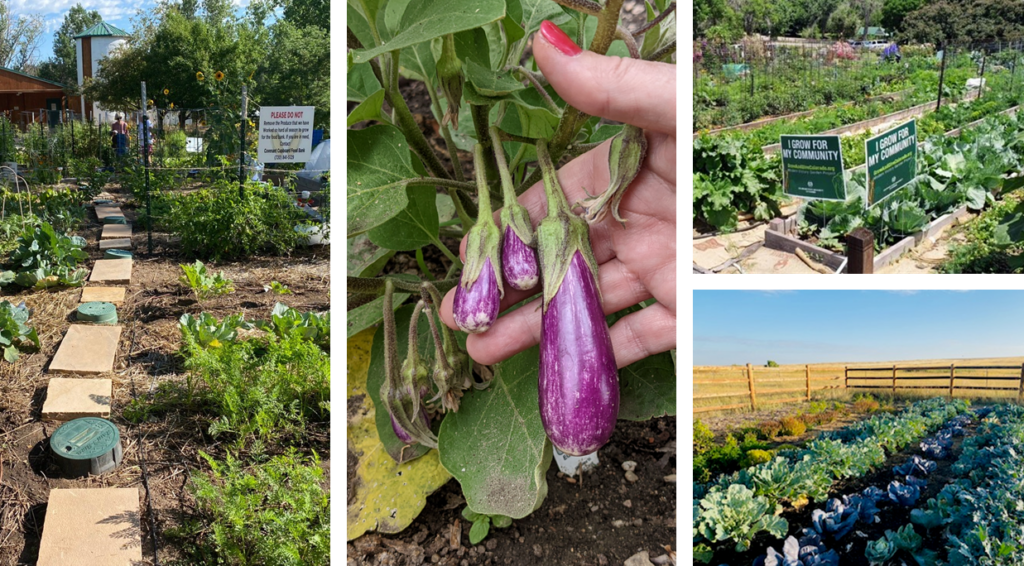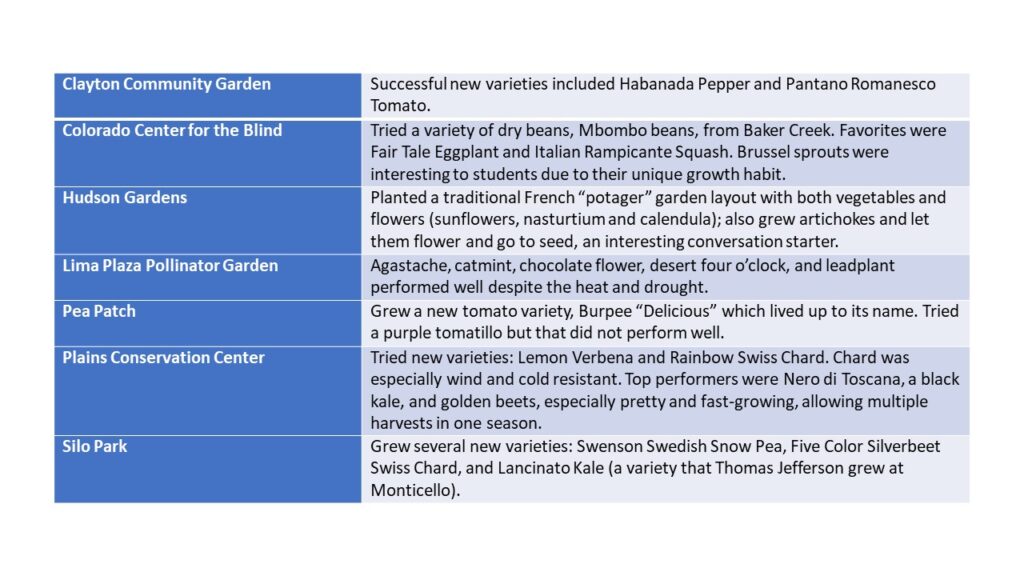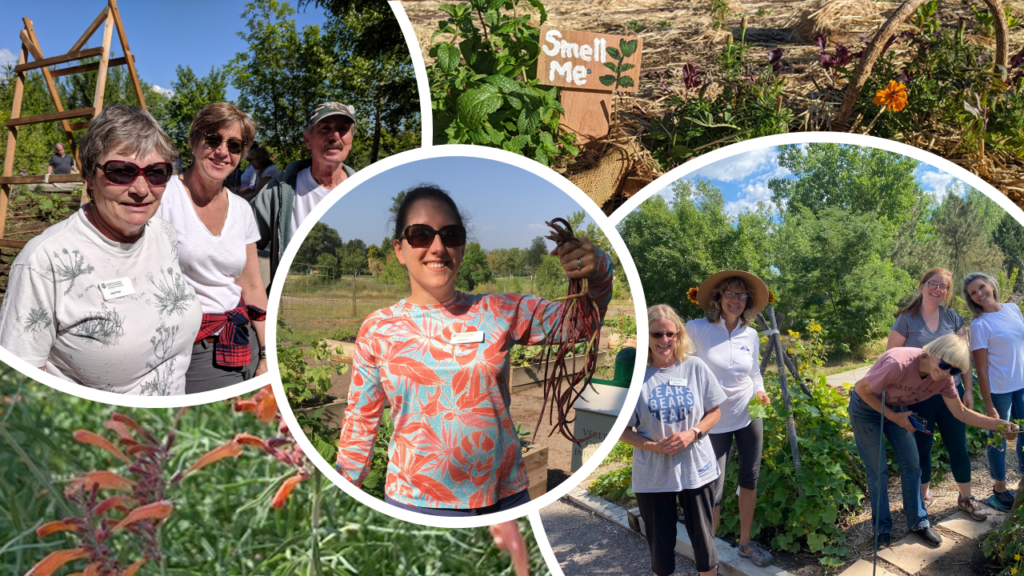Insights and Strategies of a Gardening Year – 2022
- 2023-01-05
- By mkirk
- Posted in Horticulture, The Garden Buzz
By Martha Kirk, Colorado Master Gardener
Gardens teach us a lot about how to be resourceful and much more, especially as garden seasons vary year to year. The Colorado Master Gardener volunteers in Arapahoe County oversee seven demonstration gardens throughout the county. The leaders of these gardens graciously provided insights about the 2022 season and some of the challenges they faced. Against all odds, they managed to grow and donate over 5000 pounds of produce to local food banks. Let’s dig in and see how they did it (no pun intended)!

Overcoming Challenges
- Weather is often a problem in Colorado, and 2022 was no different. Just as the demonstration gardens got underway, Denver was hit with a snowstorm on May 21. Over the next 30 days, nighttime temperatures dropped into the 40s on eight different occasions, and daytime temperatures fluctuated between 46° and 92°F. These dramatic shifts can wreak havoc on plants. Clayton Community Garden was forced to replant after the snowstorm, and their cucumber and pumpkin seedlings struggled to grow with the heat. After a soil test revealed no problems, they placed straw mulch and grass clippings around the seedlings to conserve moisture, which was successful. Lima Plaza Pollinator Garden had similar issues with the heat. The irrigation clock was adjusted, and drip lines were repaired and expanded. Some plants did not survive, but others thrived despite the heat and drought, including agastache, catmint, desert four o’clock, chocolate flower and leadplant. Colorado Center for the Blind opted to delay spring planting due to the cold weather, but the early summer heat made growing difficult.
- Animal/Insect Damage: Demonstration gardens dealt with an interesting range of critters in 2022. At Hudson Gardens, Canada geese ate the bean plants to the ground. In response, CMGs covered the beds with row cover and the plants eventually rebounded. Using row cover is also a great technique to keep insects at bay. Lima Plaza Pollinator Garden determined that rabbits had been chewing through irrigation lines, which were consequently repaired and then buried. They also built handmade cloches out of chicken wire to protect specific plants. Plains Conservation Center discovered that rabbits had snuck through perimeter fencing and decimated over 100 newly planted brassicas. The fencing was repaired but some plants were too far gone and had to be replaced. Colorado Center for the Blind had problems with Japanese beetles, Mexican bean beetles and aphids. CMGs are taught that a blast of water can knock down aphids and hand-picking beetles is effective at reducing populations. Clayton Community Garden was challenged with squash bugs. CMGs soon learned how to recognize squash bug eggs and managed the infestation by removing leaves with egg masses and hand-picking adult beetles. Silo Park Demonstration Garden faced anthracnose on all the cucumbers, even on varieties that had been carefully selected for their resistance. CMGs managed this fungal disease by removing infected leaves and sterilizing pruning tools between cuts. They also discovered voles in the garden and subsequently placed screen on the vole entrance holes.

- Site Conditions: Shade, slope and wind present their own unique challenges to gardeners. Pea Patch Demonstration Garden is situated on a slope, which historically has made watering difficult. Building raised beds with drip lines several years ago continues to benefit this garden in being a top producer. Plains Conservation Center is an open plains garden where wind is a huge factor. Fencing, berms, hedges and other manmade structures are techniques that can be employed to help mitigate wind. Silo Park, Hudson Gardens and Colorado Center for the Blind have seen an increase in shade as nearby trees grow larger. In some cases, trees can be pruned to allow more sunlight to reach garden beds.
Top Performers and Fun New Favorites
All demonstration garden team leaders look forward to getting a jump on the next season. They begin early to plan, select varieties, and secure sources of seed well in advance of the next year. The process involves assessing what worked, what didn’t and why, and researching new varieties that may work. Demonstration gardens include reliable performers such as tomatoes, peppers, beans, Swiss chard and kale, however new varieties are considered since they may become next year’s top performers. Here are some favorites and not-so-favorites from 2022.


A Recipe for Success
Gardening in Colorado can be challenging but also rewarding. It requires a dash of patience, an ounce of persistence, a cup of resilience, a tablespoon of curiosity and sometimes good old-fashioned observation and detective work to solve problems. Hopefully some of this information will help solve problems in your own gardens. When in doubt, contact the master gardener office at 303-730-1920 or mastergardener@arapahoegov.com. Most of all, remember to have fun!
Horticulture Resources
- Garden Buzz Archives
- CSU Extension Resources
- Colorado Master Gardener Program
- Foothills to Plains Native Plant Master Program
- Native Bee Watch Community Science Program
- The Co-Hort Blog
- PlantTalk Colorado
- Soil Testing
- Plant Select
- Emerald Ash Borer
- Japanese Beetle
- Colorado State Forest Service
- Ask an Expert

